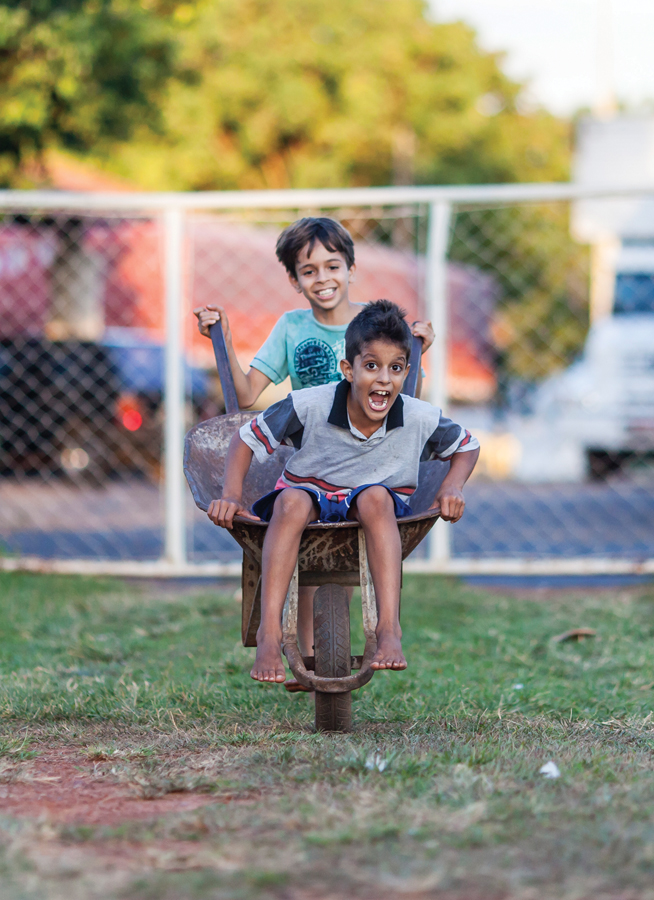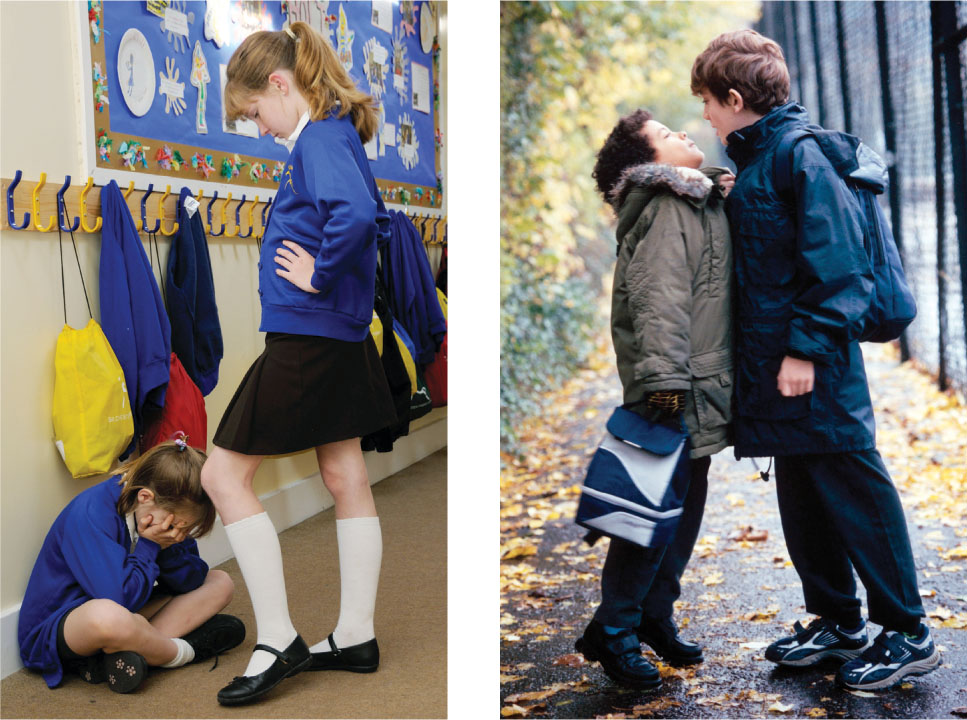13.3 The Peer Group
Peers become increasingly important in middle childhood. School-
The Culture of Children
child culture The particular habits, styles, and values that reflect the set of rules and rituals that characterize children as distinct from adult society.
Peer relationships, unlike adult–

Child culture includes the customs, rules, and rituals that are passed down to younger children from slightly older ones. Jump-
Throughout the world, child culture encourages independence from adults. Many children reject clothes that parents buy as too loose, too tight, too long, too short, or wrong in color, style, brand, decoration, or some other aspect that adults might not notice.
Appearance is important for child culture, but more important are relationships with adults. Classmates pity those (especially boys) whose parents kiss them (“mama’s boy”), tease children who please the teachers (“teacher’s pet,” “suck-
The culture of children is not always benign. For example, because communication with peers is vital, children learn the necessary languages. Parents proudly note how well their bilingual children speak a second language, but parents are distressed when their children spout their peers’ curses, accents, and slang. Seeking independence from parents, children find friends who defy authority, sometimes harmlessly (passing a note in class), sometimes not (shoplifting, smoking).
385
Friendships
Teachers may try to separate friends, but most developmentalists realize that friends help each other learn both academic and social skills (Bagwell & Schmidt, 2012). Friends affect attitudes as well as behavior. It is mistake to assume that friends are a distraction, or a source of trouble, although obviously each relationship is distinct. Aggressive friends are sought out by other aggressive children, and then they both are mean to outsiders, but they may learn loyalty via the friendship (Rubin et al., 2013).
Remember Yolanda and Paul from Chapter 12? Their friends guided them:
Yolanda:
There’s one friend…she’s always been with me, in bad or good…She’s always telling me, “Keep on going and your dreams are gonna come true.”
Paul:
I think right now about going Christian, right? Just going Christian, trying to do good, you know? Stay away from drugs, everything. And every time it seems like I think about that, I think about the homeboys. And it’s a trip because a lot of the homeboys are my family, too, you know?
[quoted in Nieto, 2000, pp. 220, 149]
Yolanda went to college; Paul went to jail.
Children want to be liked; consequently they learn faster and feel happier when they have friends. If they had to choose between being friendless but popular (looked up to by many peers) or having close friends but being unpopular (ignored by peers), most would choose to have friends (Bagwell & Schmidt, 2012). A wise choice.
Friendships become more intense and intimate over the years of middle childhood, as social cognition and effortful control advance. Six-
Older children tend to choose friends whose interests, values, and backgrounds are similar to their own. By the end of middle childhood, close friendships are almost always between children of the same sex, age, ethnicity, and socioeconomic status (Rubin et al., 2013). This occurs not because children naturally become more prejudiced over the course of middle childhood (they do not) but because they seek friends who understand and agree with them.
Gender differences persist in activities (girls converse more whereas boys play more active games), but both boys and girls want best friends and usually find them. Having no close friends at age 11 predicts depression at age 13 (Brendgen et al., 2010).
Popular and Unpopular Children
In North American culture, shy children are not popular, but a 1990 survey in Shanghai found that shy children were liked and respected (X. Chen et al., 1992). Twelve years later, assertiveness became more valued in China: A survey from the same schools found shy children less popular than their shy predecessors had been (X. Chen et al., 2005). A few years later, a third study in rural China found shyness still valued; it predicted adult adjustment (X. Chen et al., 2009). Obviously, cohort and context matter.
Recently in the United States, two types of popular children and three types of unpopular children have become apparent in middle childhood. First, at every age, children who are “kind, trustworthy, cooperative” are well liked. By the end of middle childhood, the second type of popularity begins: children who are “athletic, cool, dominant, arrogant, and…aggressive” (Cillessen & Mayeux, 2004a, p. 147; Rodkin & Roisman, 2010).
386
aggressive-
withdrawn-
As for the three types of unpopular children, some are neglected, not rejected; they are ignored, but not shunned. The other two types are actively rejected, either aggressive-
Bullies and Victims
bullying Repeated, systematic efforts to inflict harm through physical, verbal, or social attack on a weaker person.
Bullying is defined as repeated, systematic attacks intended to harm those who are unable or unlikely to defend themselves. It occurs in every nation, in every community, and in every kind of school (religious or secular, public or private, progressive or traditional, large or small) and perhaps in every child. As one girl said, “There’s a little bit of bully in everyone” (Guerra et al., 2011, p. 303).
Bullying may be of four types:
- Physical (hitting, pinching, shoving, or kicking)
- Verbal (teasing, taunting, or name-
calling) - Relational (destroying peer acceptance)
- Cyberbullying (using electronic means to harm another)

HENRY KING/GETTY IMAGES. LICENSED MATERIAL IS BEING USED FOR ILLUSTRATIVE PURPOSES ONLY; PERSON DEPICTED IN THE LICENSED MATERIAL IS A MODEL.
The first three types are common in primary school and begin even earlier, in preschool. Cyberbullying is more common later on. [Lifespan Link: Cyberbullying is discussed in Chapter 15.]
A key word in the definition of bullying is repeated. Almost every child experiences an isolated attack or is called a derogatory name at some point. Victims of bullying, however, endure shameful experiences again and again—
387
Although it is often thought that victims are particularly ugly or odd, this is not usually the case. Victims are chosen because of their emotional vulnerability and social isolation, not their appearance. Children who are new to a school, or children whose background and therefore home culture are unlike that of their peers, are especially vulnerable.
As one boy said,
You can get bullied because you are weak or annoying or because you are different. Kids with big ears get bullied. Dorks get bullied. You can also get bullied because you think too much of yourself and try to show off. Teacher’s pet gets bullied. If you say the right answer too many times in class you can get bullied. There are lots of popular groups who bully each other and other groups, but you can get bullied within your group too. If you do not want to get bullied, you have to stay under the radar, but then you might feel sad because no one pays attention to you.
[quoted in Guerra et al., 2011, p. 306]
Remember the three types of unpopular children? Neglected children are not victimized; they are ignored, “under the radar.” If their family relationships are good, they suffer less even if they are bullied (which they usually are not) Bowes et al., 2010).
bully-
Withdrawn-
Unlike bully-
Boys bully more than girls, usually physically attacking smaller, weaker boys. Girl bullies usually use words to attack shyer, more soft-
Causes and Consequences of Bullying
Bullying may originate with a genetic predisposition or a brain abnormality, but when a toddler is aggressive, parents, teachers, and peers usually teach emotional regulation and effortful control. If home life is stressful, discipline is ineffectual, siblings are hostile, or attachment is insecure, those lessons are not learned. Instead, young children develop externalizing and internalizing problems, becoming bullies or victims (Turner et al., 2013).
Peers are crucial. Some peer groups approve of relational bullying, and then children entertain their classmates by mocking and insulting each other (N. E. Werner & Hill, 2010). On the other hand, when students themselves disapprove of bullying, its incidence is reduced (Guerra & Williams, 2010). Age is also an important factor. For most of childhood, bullies are disliked, but a switch occurs at about age 11, when bullying becomes a way to gain social status (Caravita & Cillessen, 2012).
388
The consequences of bullying can echo for years, worsening with age. Many victims become depressed; many bullies become increasingly cruel. However, bullies and victims can be identified in first grade and get “active guidance and remediation” before their behavior becomes truly destructive (Leadbeater & Hoglund, 2009, p. 857).
Unless bullies are deterred, they and their victims risk impaired social understanding, lower school achievement, and relationship difficulties. Decades later they have higher rates of mental illness (Copeland et al., 2013; Ma et al., 2009; Pepler et al., 2004). Compared to other adults the same age, former bullies are more likely to die young, be jailed, or have destructive marriages. Bystanders suffer, too, learning less when bullying is common (Monks & Coyne, 2011; Nishina & Juvonen, 2005; Rivers et al., 2009).
Can Bullying Be Stopped?
Most victimized children find ways to halt ongoing bullying—
Especially for Parents of an Accused Bully Another parent has told you that your child is a bully. Your child denies it and explains that the other child doesn’t mind being teased.
Response for Parents of an Accused Bully: The future is ominous if the charges are true. Your child’s denial is a sign that there is a problem. (An innocent child would be worried about the misperception instead of categorically denying that any problem exists.) You might ask the teacher what the school is doing about bullying. Family counseling might help. Because bullies often have friends who egg them on, you may need to monitor your child’s friendships and perhaps befriend the victim. Talk matters over with your child. Ignoring the situation might lead to heartache later on.
We know what does not work: simply increasing students’ awareness of bullying, instituting zero tolerance for fighting, or putting bullies together in a therapy group or a classroom (Baldry & Farrington, 2007; Monks, & Coyne, 2011). This last measure tends to make daily life easier for some teachers, but it increases aggression. Since one cause of bullying is poor parent–
The school community as a whole—
Peers are crucial: If they simply notice bullying, becoming aware without doing anything that provides no help. In fact, some bystanders feel morally disengaged from the victims, which increases bullying. Others are sympathetic but feel powerless (Thornberg & Jungert, 2013). However, if they empathize with victims, feel effective (high in effortful control), and refuse to admire bullies, classroom aggression is reduced (Salmivalli, 2010).
Efforts to change the entire school—
A review of ways to halt bullying (Berger, 2007) finds that:
- Everyone in the school must change, not just the identified bullies.
- Intervention is more effective in the earlier grades.
- Evaluation is critical: Programs that seem good might be harmful.
This final point merits emphasis. Longitudinal research on whole-
389
SUMMING UP
School-
Most children experience occasional peer rejection. However, some children are victims, repeatedly rejected and friendless, and experience physical, verbal, or relational bullying. Bullies may have friends and social power in middle childhood and early adolescence, but they are likely to suffer in adulthood. Some efforts to reduce bullying succeed and some do not. A whole-